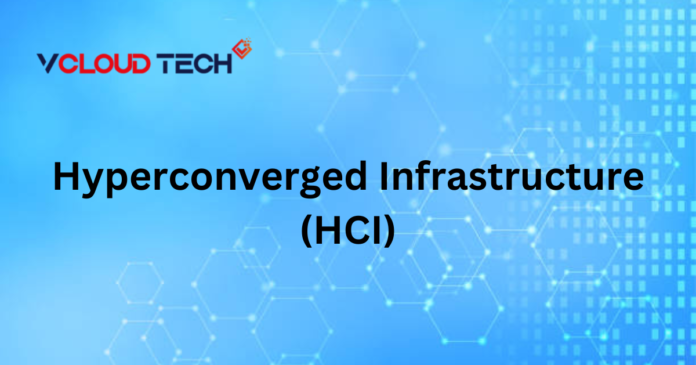In the fast-paced world of IT infrastructure, one term that has gained significant traction is hyperconverged infrastructure (HCI). As businesses continually seek ways to streamline operations and bolster Cybersecurity, HCI emerges as a transformative solution that integrates various IT components into a unified system. In this article, we will delve into the intricacies of HCI, exploring its components, benefits, and pivotal Role in the evolving cybersecurity landscape.
Introduction to Hyperconverged Infrastructure
In the ever-evolving realm of IT infrastructure, organizations constantly seek innovative solutions that enhance efficiency and security. This quest has led to the emergence of Hyperconverged Infrastructure (HCI) as a game-changer in IT. But what exactly is HCI, and how does it revolutionize how we manage and secure our digital landscapes?
Advantages of Hyperconverged Infrastructure
The adoption of HCI brings forth many advantages that resonate with organizations striving for agility and cost-effectiveness in their IT strategies.
Enhanced Scalability
One of the standout features of HCI is its scalability. Traditional infrastructures often need help scaling up or down, leading to inefficiencies and increased costs. With HCI, organizations can seamlessly scale their infrastructure to meet growing demands, ensuring optimal performance at all times.
Simplified Management
Managing disparate IT components can be a daunting task. HCI simplifies this complexity by providing a unified interface for managing all infrastructure elements. This reduces the burden on IT teams and minimizes the risk of errors associated with manual management.
Cost Efficiency
Cost considerations are paramount in any IT strategy. HCI offers a cost-effective solution by consolidating hardware and streamlining management. The result is a reduction in both capital and operational expenses, making HCI an attractive option for organizations aiming to maximize their ROI.
The Role of Hyper-convergence in Cybersecurity
As businesses navigate an increasingly digital landscape, the need for robust Cybersecurity measures has never been more critical. HCI plays a pivotal role in enhancing the security posture of organizations, addressing vulnerabilities, and fortifying defenses.
Strengthening Security Measures
Traditional IT infrastructures often present vulnerabilities due to the complexity of managing various components. HCI’s integrated approach minimizes potential security gaps, providing a more secure foundation for critical business operations.
Addressing Vulnerabilities
In the realm of cybersecurity, identifying and addressing vulnerabilities promptly is paramount. HCI’s centralized management enables swift responses to potential threats, ensuring that security protocols are consistently enforced across all components.
Hyperconvergence Storage Solutions
A cornerstone of HCI is its innovative approach to data storage. Traditional storage solutions are often plagued by inefficiencies and complexities that hinder overall system performance.
Revolutionizing Data Storage
HCI adopts a software-defined storage model, breaking free from the constraints of traditional storage architectures. This enhances storage efficiency and facilitates seamless data movement across the infrastructure, promoting optimal resource utilization.
Hyperconverged Cloud Integration
In an era where cloud computing is a cornerstone of digital transformation, integrating hyperconvergence with cloud services becomes a crucial consideration.
Bridging the Gap Between On-Premises and Cloud
HCI bridges on-premises infrastructure and the cloud, providing a seamless and integrated experience. This integration allows organizations to leverage the flexibility and scalability of the cloud while maintaining control over critical aspects of their infrastructure.
Ensuring Seamless Operations
The integration of hyperconverged infrastructure with cloud services enhances operational efficiency. Whether deploying new applications or scaling resources dynamically, the synergy between HCI and the cloud ensures that organizations can adapt to evolving business needs with agility and ease.
Implementing Hyperconverged Infrastructure at vCloud Tech
As we explore the broader landscape of HCI, it’s crucial to examine how vCloud Tech, a leading provider of IT infrastructure and cybersecurity solutions, incorporates hyperconverged solutions into its offerings.
Tailored Solutions for IT Challenges
vCloud Tech understands that every organization faces unique IT challenges. Through a consultative approach, vCloud Tech tailors hyperconverged solutions to meet each client’s specific needs, ensuring that the benefits of HCI are maximized.
Future Trends in Hyperconverged Infrastructure
As technology continues to evolve, so does the landscape of hyperconverged infrastructure. Examining future trends provides insights into the ongoing evolution of HCI.
Emerging Technologies and Innovations
From edge computing to AI-driven optimizations, emerging technologies are shaping the future of HCI. Keeping a pulse on these innovations allows organizations to stay ahead of the curve and harness the full potential of hyperconverged solutions.
Anticipated Developments
Anticipating developments in HCI is crucial for organizations planning their IT strategies. Whether it’s the integration of 5G or advancements in data processing capabilities, staying informed ensures that organizations can make informed decisions that align with their long-term goals.
Choosing the Right Hyperconvergence Solution
With various hyperconvergence solutions available, choosing the right one for your organization requires careful consideration of multiple factors.
Factors to Consider
Several factors influence the choice of a hyperconvergence solution, from performance requirements to budget constraints. Organizations must assess their unique needs and align them with the features offered by different HCI providers to make an informed decision.
Customization Options
The ability to customize hyperconvergence solutions is a key consideration. Organizations should seek providers that offer flexibility in tailoring HCI to their specific requirements, ensuring that the solution seamlessly integrates with existing infrastructure and future growth plans.
Addressing Common Misconceptions about Hyperconvergence
As with any technological advancement, hyperconvergence has its fair share of misconceptions. Addressing these myths is crucial for fostering a clear understanding of what HCI truly entails.
Debunking Myths
From concerns about performance to misconceptions about complexity, debunking myths surrounding hyperconvergence is essential. By dispelling these misconceptions, organizations can confidently make informed decisions about adopting HCI.
Clarifying Misunderstandings
In addition to debunking myths, it’s vital to clarify any misunderstandings that may exist. This ensures that organizations approach hyperconvergence with accurate information, fostering a positive and realistic expectation of what HCI can deliver.
The Impact of Hyperconverged Infrastructure on Business Operations
The adoption of hyperconverged infrastructure goes beyond the realm of IT. Its impact on overall business operations is substantial, influencing efficiency and driving innovation.
Improving Efficiency
HCI’s streamlined approach to IT infrastructure translates into improved efficiency across business operations. From faster deployment of applications to reduced downtime, the efficiency gains are tangible and contribute to overall productivity.
Driving Innovation
Innovation often thrives in an environment where IT is an enabler rather than a hindrance. HCI’s ability to simplify and enhance IT operations allows organizations to innovate, driving continuous improvement and adaptation to market dynamics.
Hyperconvergence Adoption Strategies
Adopting hyperconverged infrastructure requires a well-thought-out strategy. Organizations must navigate the implementation process to ensure a smooth transition.
Planning for Implementation
Before embarking on the HCI journey, organizations should comprehensively assess their current infrastructure and define clear objectives. This planning phase lays the groundwork for a successful implementation that aligns with organizational goals.
Overcoming Potential Challenges
While the benefits of HCI are substantial, challenges may arise during the adoption phase. Proactive measures, such as adequate training and thorough testing, can help organizations overcome potential hurdles and ensure a seamless transition to hyperconverged infrastructure.
Realizing the ROI of Hyperconverged Infrastructure
Return on investment (ROI) is a critical metric for any IT investment. Calculating the ROI of hyperconverged infrastructure involves assessing both tangible and intangible benefits.
Calculating Returns
Quantifying the returns on a hyperconvergence investment involves evaluating factors such as cost savings, improved performance, and enhanced security. Organizations should employ a comprehensive approach to ensure a realistic and accurate ROI assessment.
Long-Term Benefits
While immediate returns are crucial, the long-term benefits of HCI are equally significant. From future scalability to ongoing cost efficiencies, organizations stand to gain sustained advantages from their investment in hyperconverged infrastructure.
VMware Cloud Foundation in Hyperconverged Infrastructure
In the dynamic landscape of hyperconverged infrastructure (HCI), where seamless integration and efficient management are paramount, VMware Cloud Foundation emerges as a powerhouse solution. As organizations seek robust, scalable, and secure IT environments, VMware Cloud Foundation is a game-changer, seamlessly integrating computing, storage, networking, and cloud management into a single platform.
Introduction to VMware Cloud Foundation
At the core of hyperconverged infrastructure lies the need for a unified, comprehensive solution that simplifies operations. VMware Cloud Foundation, developed by virtualization giant VMware, takes center stage by providing an integrated platform encompassing computing, storage, networking virtualization, and cloud management. This cohesive approach sets the stage for enhanced agility, scalability, and operational efficiency.
The Four Pillars of VMware Cloud Foundation
VMware Cloud Foundation is built upon four foundational pillars, each addressing critical aspects of the IT infrastructure:
Compute Virtualization
VMware Cloud Foundation leverages vSphere, the leading virtualization platform, to provide robust compute virtualization. This ensures optimal utilization of resources and seamless workload management.
Storage Virtualization
The platform incorporates vSAN, VMware’s software-defined storage solution, enabling organizations to achieve high-performance storage with the flexibility to scale.
Network Virtualization
NSX, VMware’s network virtualization platform, is integral to Cloud Foundation. It empowers organizations to create and manage virtual networks, enhancing overall network agility and security.
Cloud Management
VMware Cloud Foundation integrates vRealize Suite for cloud management, offering a comprehensive set of automation, operations, and optimization tools. This ensures streamlined management across private and public clouds.
Benefits of VMware Cloud Foundation in Hyperconverged Infrastructure
Simplified Lifecycle Management
One of the standout features of VMware Cloud Foundation is its streamlined lifecycle management. The platform automates the deployment, patching, and upgrading of the entire HCI stack, reducing operational overhead and minimizing the risk of errors.
Enhanced Scalability
VMware Cloud Foundation provides a scalable architecture that grows with the organization’s evolving needs. Whether expanding the infrastructure to accommodate increased workloads or integrating with the cloud, scalability is a key advantage.
Integrated Cloud Management
Including vRealize Suite ensures a unified and consistent management experience across on-premises and cloud environments. This integration simplifies operations, allowing IT teams to focus on strategic initiatives rather than routine tasks.
Robust Security Measures
Security is a top priority in HCI, and VMware Cloud Foundation doesn’t disappoint. With features like micro-segmentation through NSX and comprehensive security policies, organizations can fortify their infrastructure against evolving cyber threats.
Accelerated Time-to-Value
The integrated nature of VMware Cloud Foundation accelerates the deployment of the entire HCI stack. This reduces the time and effort required for initial setup and ensures a faster time-to-value for organizations adopting hyperconverged infrastructure.
Use Cases and Deployment Scenarios
Data Center Modernization
VMware Cloud Foundation is an ideal solution for modernizing their data centers. Consolidating and virtualizing resources paves the way for a more agile and efficient data center infrastructure.
Hybrid Cloud Deployments
With seamless integration with leading public cloud providers, VMware Cloud Foundation facilitates hybrid cloud deployments. This allows organizations to leverage the flexibility of the cloud while maintaining control over critical aspects of their infrastructure.
Business Continuity and Disaster Recovery (BCDR)
The robustness of VMware Cloud Foundation extends to business continuity and disaster recovery scenarios. Providing a resilient and scalable infrastructure ensures that organizations can maintain operations even in the face of unforeseen disruptions.
Implementing VMware Cloud Foundation with vCloud Tech
As a leading provider of IT infrastructure and cybersecurity solutions, vCloud Tech leverages VMware Cloud Foundation to empower organizations with cutting-edge hyperconverged solutions.
Tailored Deployments
vCloud Tech understands that each organization has unique requirements. By leveraging VMware Cloud Foundation, vCloud Tech tailors hyperconverged deployments to meet specific needs, ensuring optimal performance and efficiency.
Consultative Approach
Through a consultative approach, vCloud Tech collaborates with clients to understand their business objectives and challenges. This ensures that the implementation of VMware Cloud Foundation aligns with the organization’s broader goals.
Conclusion
In conclusion, hyperconverged infrastructure is a transformative force in IT. From revolutionizing data storage to enhancing cybersecurity measures, HCI offers a holistic solution that aligns with the dynamic needs of modern organizations. As we navigate the future of IT infrastructure, the integration of HCI with cloud services and its ongoing evolution underscores its significance in driving innovation and efficiency.





